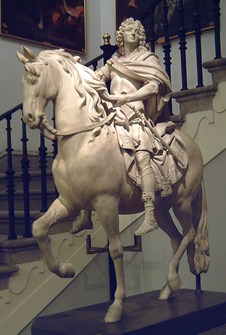Philip V and a lost statue
 The grandson of Louis XIV of France, Philip V of Bourbon (1683-1746), the former Duke of Anjou, ascended to the throne of Spain in 1700, boasting the most direct relationship with the late King Charles II. However, it was not until the peaces of Utrecht (1713) and Rastadt (1714), which ended the War of the Spanish Succession (1701-1713), that his rights to the throne were finally recognized, in exchange for giving up a substantial part of the ancient possessions of the Habsburgs, in particular the Italian territories and the Southern Netherlands. After leaving the government to his eldest son LouisLouis of Bourbon (1707-1724) was the eldest son of Philip V of Spain (1683-1746) and his first wife Maria Luisa of Savoy. He reigned after his father abdicated in his favour, on 15 January 1724, until his death from smallpox on 31 August of the same year. Philip V was thus forced to return to the throne. for a few months in 1724, who then died of smallpox, Philip returned to the throne and engaged in subsequent years to regain the lost territories, taking part in the War of the Polish Succession (1733-1738) and the War of the Austrian Succession (1741-1748). Thus the kingdoms of Sicily and Naples (Treaty of Vienna of 1738) were recovered. In domestic policy, Philip V and his ministers committed themselves to the kingdom introducing a series of reforms, starting with the Nueva Planta decrees, issued in 1707. They eliminated local governments, changing the relationship between Madrid and the provinces significantly, abolishing the kingdoms of Aragon, Valencia, Majorca and the respective local assemblies, the cortes, while the municipalities were established along with mayors. At the central level the Consejos of Aragon, Italy and Flanders were suppressed and the Departments of State were born, composed of officials appointed by the King and coordinated by the Secretary of State. Other important reforms regarded the tax system, education and the military.
The grandson of Louis XIV of France, Philip V of Bourbon (1683-1746), the former Duke of Anjou, ascended to the throne of Spain in 1700, boasting the most direct relationship with the late King Charles II. However, it was not until the peaces of Utrecht (1713) and Rastadt (1714), which ended the War of the Spanish Succession (1701-1713), that his rights to the throne were finally recognized, in exchange for giving up a substantial part of the ancient possessions of the Habsburgs, in particular the Italian territories and the Southern Netherlands. After leaving the government to his eldest son LouisLouis of Bourbon (1707-1724) was the eldest son of Philip V of Spain (1683-1746) and his first wife Maria Luisa of Savoy. He reigned after his father abdicated in his favour, on 15 January 1724, until his death from smallpox on 31 August of the same year. Philip V was thus forced to return to the throne. for a few months in 1724, who then died of smallpox, Philip returned to the throne and engaged in subsequent years to regain the lost territories, taking part in the War of the Polish Succession (1733-1738) and the War of the Austrian Succession (1741-1748). Thus the kingdoms of Sicily and Naples (Treaty of Vienna of 1738) were recovered. In domestic policy, Philip V and his ministers committed themselves to the kingdom introducing a series of reforms, starting with the Nueva Planta decrees, issued in 1707. They eliminated local governments, changing the relationship between Madrid and the provinces significantly, abolishing the kingdoms of Aragon, Valencia, Majorca and the respective local assemblies, the cortes, while the municipalities were established along with mayors. At the central level the Consejos of Aragon, Italy and Flanders were suppressed and the Departments of State were born, composed of officials appointed by the King and coordinated by the Secretary of State. Other important reforms regarded the tax system, education and the military.
An equestrian statue depicting Philip V was built at the beginning of his long reign, in 1702-1703, by the Neapolitan sculptor Lorenzo VaccaroA sculptor, architect and painter in Naples, Lorenzo Vaccaro (ca. 1655-1706) was formed following the example of Cosimo Fanzago. A prominent figure of the late Neapolitan Baroque, he was also influenced by Bernini and by Solimena. His son, Domenico Antonio, also an artist, also began to work under him.. The statue, located in the Piazza del Gesù Nuovo, however, was demolished in 1707 upon the arrival of the Austrians in the city of Naples. A miniature model of the statue, taken to Madrid in 1705 by the Duke of Popoli, is now preserved in the Museo del Prado. The king is represented in the guise of a Roman general who paraded in a triumphal parade in his honor. In 1780, Charles III announced a competition for the creation of an equestrian statue that would represent his father Philip V and could be installed, in imitation of the Habsburg monarchs, in a square in Madrid. Though this project was never undertaken, the Academia de Bellas Artes de San Fernando in Madrid still retains some of the models submitted for the competition.
